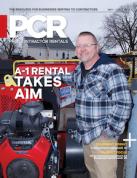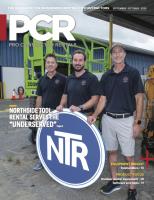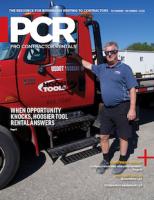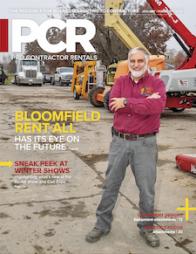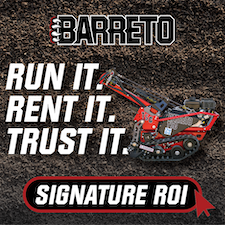Industry Outlook: Mini excavators move up
Smaller sizes, increased power and hybrid-powered units open rental opportunities.
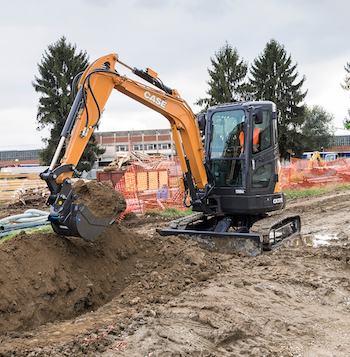 |
| Case and other manufacturers are offering a range of models that have a variety of standard features designed to improve productivity and performance. |
 |
| Models may have zero, short-radius or conventional tail swing design, making them the optimal unit for certain jobs. |
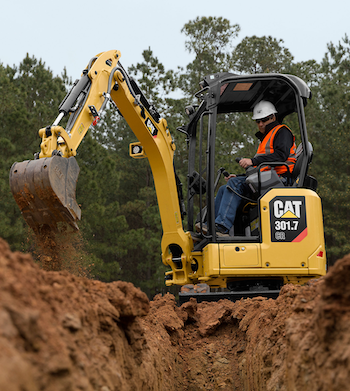 |
| Cat Next Generation (Next Gen) mini excavators are built with more power in smaller units and engineering that helps reduce cost of ownership, such as hydraulic lines that are protected from damage inside the boom. When repairs are needed, they are easy to complete. |
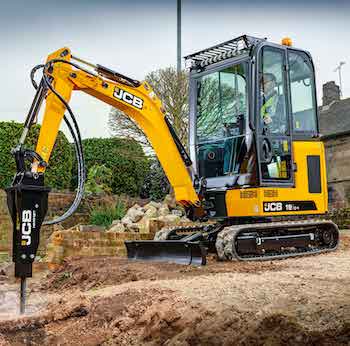 |
| Increasingly, attachments are making mini excavators into much more than machines solely used for trenching or other digging tasks. |
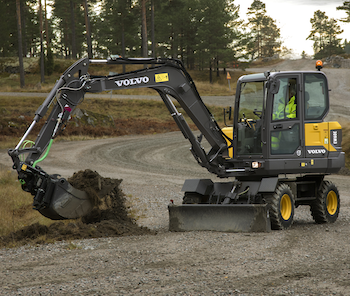 |
| Wheeled mini excavators offer the flexibility and power of tracked units but are easier to transport on job sites where the unit needs to be moved from task to task.Pro Contractor Rentals asked leading equipment manufacturers and experts about the developments and trends in mini excavators and it’s clear the market is trending toward smaller and more powerful units that are getting into spaces that were once reserved for laborious pick-and-shovel duty. |
Longer service intervals and more intuitive operation are quickly become must-haves on late-model units. Here’s how they see mini excavators increasingly fit into equipment rental fleets.
 |
|
Jason Boerger |
Easy service and attachments increase rentability
Compact excavators in the 3 to 4-metric-ton size class continue to be a popular choice for rental companies. Their compact size and versatility help them handle many different jobs across multiple markets from construction to landscaping.
Ease of maintenance continues to be a focus for many manufacturers. This provides great value to rental stores and rental houses because it reduces the amount of time that must be spent maintaining a machine, so the machine is out on rent instead of in the shop and providing consistent revenue. For example, the Bobcat
R-Series excavator cooling package can be easily separated without tools to easily clean the surface areas of the radiator, oil cooler and AC condenser cores.
The evolution of telematics on compact equipment – including compact excavators – provides great value for rental stores and rental houses. It gives them greater visibility to what is going on with their machines not only when it comes to maintenance but where those machines are at all times.
Bobcat Company has updates to its telematics offering. Customers now have the ability to receive notifications via email from the machine about fault codes, routine maintenance alerts and geofencing through the Bobcat Owner Portal
Customers can know what their machine is doing at all times, which enables them to manage the fleet remotely. This is very beneficial for rental stores and rental houses with multiple machines at different job sites all at one time.
Attachments continue to create rental opportunities. Buckets continue to be very popular and widely used, but other attachments like flail mowers, augers, clamps, breakers and plate compactors make compact excavators even more versatile and help customers with efficiency on their job sites. This also helps rental stores and rental houses increase machine utilization, keeping them out on rent for longer periods of time because of the multiple jobs that can be accomplished with just one machine and a few attachments.
 |
|
Ed Brenton |
Rental units gain in popularity
Mini excavator sales into the rental industry remain consistent compared to last year; sales into independent rental facilities are slightly down compared to 2018, but not in such a way that indicates any kind of a major industry swing or trend. Forecasters at Case CE simply continue to see that mini excavators remain one of the most trusted pieces of equipment that rental houses add to their fleets because of their versatility.
Many mini excavators moving into rental businesses are being outfitted with couplers and thumbs. Couplers give rental businesses and their customers the flexibility to switch between buckets and attachments. Thumbs also add great material handling capability to the unit.
Larger rental houses or equipment dealer rental outlet will rent larger machines like the CX57C and CX60C because they have greater power and productivity; smaller independent rental businesses may focus on smaller equipment that can fit into tight areas or be hauled without requiring special licensing or hauling equipment. Case CE offers a sweet-spot machine – the Case CX37C which, at just under 8,000 pounds, can be transported easily by almost anyone with a truck or a trailer.
Although mini excavators are overshadowed by skid steers and compact track loaders, mini excavators are an excellent tool carrier for attachments such as hammers and compactors. They are also extremely efficient as material handlers when outfitted with a thumb. Rental businesses that have a range of couplers, bucket sizes and attachments available have ultimately, a more versatile machine that will be more attractive to rent.
Today, the entire Case lineup of C Series mini excavators are wired for telematics from the factory. That allows rental businesses to subscribe to Case SiteWatch telematics and monitor important factors such as engine hours and machine location. This kind of utilization monitoring provides a number of benefits in rental applications: accurate hours of use data for billing purposes; identifying the location of machines that are overdue to be returned; and possibly identifying machines that are sitting static somewhere that may fill a need for another customer.
While the construction market is still experiencing growth, we expect the practice of renting or renting-to-own to continue expanding as business owners and fleet managers become more savvy about managing total cost of ownership, the carrying costs of equipment and profitability from job to job.
The role of a rental business as a business partner and consultant to its customers is to come up with new and innovative ways to provide customers with the tools and equipment they need. This will position them for even greater success and can be in the form of innovative rates or long-term rental plans, or as simple as a regularly scheduled meeting with that customer to go over their upcoming needs.
It’s important for rental businesses to think of the entire life cycle of a machine and what it could mean to their local market. For instance, rather than looking at a machine as simply an asset to bill hours of use against, think of its next life: is there a large demand for used construction equipment in your market? Managing that asset to get the greatest profitability out of it over a set amount of time, and then putting it up for sale as a used machine at a certain number of hours, or during a season of heavier buying patterns in your market, will ultimately ensure the greatest profitability on that machine. This should be part of a deliberate business plan.
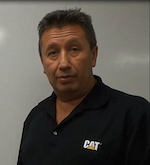 |
|
Greg Worley |
Design for lower cost of ownership; repair ease
Improved cost of ownership is one of the leading trends with mini excavators. What we’ve heard from our customers, especially rental customers, is they want increased service intervals, lowered cost of replacement parts and simplicity with replacing parts. The Cat Next Generation (Next Gen) of mini excavators have a robust design to avoid some of the common repairs, like hydraulic lines protected in the boom. Also, our tilting cab gives accessibility to the machine core components, limiting hours spent on repairs. Even though these machines are relatively new to the market, there are promising figures when it comes to owning and operating costs. Benchmarking against our current machines, we’re seeing 15 percent lower operating costs on the 1- and 2-ton Next Gen models.
The Next Gen Cat mini excavators have an improved operating experience, so if you want to run them like a skid steer, you can. Stick steer travel control easily switches from traditional controls with levers and pedals to joystick controls with the push of a button. The benefit of less effort and improved control is literally in your hands.
When they were first introduced, mini excavators were used mostly for trenching. They are still ideal for those types of tasks and because they are so easy to use, newer operators can work with them quite comfortably in an array of industries. The type of applications where these machines are being used grows all the time. They are perfect rental equipment, especially for customers who want to operate the machines themselves. Plus, the availability of different work tools is making mini excavators even more desirable and versatile. They add to the number of applications and put more demands on machine performance.
 |
|
Corey Rogers |
Attachment flexibility for tight quarters
Hyundai’s 9A series compact excavators combine power, efficiency and reliability with the ability to work productively in confined spaces. Seven models range in operating weight from 3,747 to 19,290 pounds. All machines feature a boom swing function that can swing 75 degrees to the left and 50 degrees to the right for efficient work in congested areas. Select models offer zero-tail swing to allow for even more flexibility in tight spaces.
The Hyundai 9A series models include a variety of standard features that provide exceptional value, including thumb brackets, large dozer blades, hydraulic quick-couplers for attachments, and hydraulics-ready auxiliary piping to provide the versatility needed to take on a variety of jobs.
Hyundai very recently announced improvements to its 3-1/2-ton class Hyundai R35Z-9A compact excavator that features a zero-tail swing design for optimum maneuverability in confined work spaces. New standard features include a Werk Brau-compatible thumb bracket, a diverter valve for easy switching between a thumb or attachment, proportional control levers with two-way piping, pin-grabber style dual-locking quick coupler and O/C piping, enhanced bucket design with lifting-eye and two-piece tooth design for easy replacement, increased curve profile on dozer blade for better grade and cutting ability, an easily replaceable cutting edge to the dozer blade, a wider opening engine compartment, and a durable centered boom LED work light for improved job site illumination. A new optional feature is the 4-way angle dozer blade.
Hyundai used the Voice of the Customer (VOC) process to stay abreast of customer needs and expectations. For example, the recent improvements to the R35Z-9A excavator are the result of valuable input from a VOC meeting we conducted with North American dealers and customers. Frequent competitive comparison tests and annual VOC meetings with dealers and customers provide important data and direction to help us improve current machine models and contribute to the development of new products.
Hyundai greatly values our customers’ ideas and feedback. Customers know their investment is protected into the future, thanks to Hyundai’s best-in-class, hassle-free 3-year/3,000-hour warranty and 5-year/10,000-hour structural guarantee.
Innovative, precision-designed hydraulic system technologies make the Hyundai 9A series compact excavators fast, smooth and easy to control. A standard capability common to all 9A series models is boom swing, which allows the operator to offset the boom 75 degrees to the left and 50 degrees to the right, facilitating close work alongside foundations and other structures, especially in congested areas.
The Hyundai 9A series models offer a spacious, ergonomically designed cab that reduces noise and increases visibility and comfort with features such as powerful air conditioning, suspension seat and fold-up travel pedals for enhanced floor space. A tilting left-side console makes it easier for the operator to enter and exit the cab, and the left and right control levers are located for convenient access. The optional lever-pattern-change valve is positioned for easy access. It allows joystick control to be changed from SAE to ISO pattern, depending on operator preference. Button selections are provided for auto idle mode, max power mode and travel speed. The cabs on the Hyundai 9A series machines are all TOPS, ROPS and FOPS certified. Other safety features include optional boom and arm cylinder locks, an optional overload alarm, and five-inch rectangular rearview mirrors on both sides of the cab.
Hyundai recently announced the addition of its exclusive HiMate remote management system as standard on three Hyundai compact excavators – the R55-9A, R60CR-9A and R80CR-9A. HiMate previously was available only on the Hyundai HX series of full-sized crawler excavators, HW full-sized wheeled excavators and the HL900 series wheel loaders.
HiMate uses GPS technology to track Hyundai construction machines at any time and in any location. The system monitors key machine components such as the engine, hydraulics and electrical system. It gives our customers a variety of time- and money-saving benefits. Importantly, it promotes greater preventive maintenance to reduce equipment downtime.
Hyundai provides free use of HiMate for five years on the standard cellular configuration, which sends and receives data from machines in the field via cellular networks. Configuring HiMate-equipped machines with satellite connectivity requires the purchase of additional hardware and a subscription.
HiMate enables users to view and manage operating information, select and activate alarms, and call up reports such as alarm incidents and maintenance status. For owners of multiple Hyundai wheel loaders and excavators, HiMate can monitor any specific machine or combination of machines. In addition to providing complete, real-time information on the location and operation of Hyundai wheel loaders and excavators, HiMate also supports theft prevention through such capabilities as geo-fencing and alarm notifications.
Chris Lucas, Product Manager for Mini Excavators, JCB North America
Looking toward all-electric models
Over the past few years, mini excavator manufacturers have started to assess and plan for the potential impact of all-electric or hybrid machines on market demand. JCB is an innovator in this segment and proactively engaged its engineering team several years ago to develop an electric mini excavator that could meet emissions standards and likely market expectations without compromising on performance.
At the ARA trade show this year, JCB offered a preview of the innovative JCB 19C-ETEC, which is the first electric mini excavator of its kind in North America. It has the same operating characteristics and capabilities as the JCB 19C diesel mini excavator, but with zero emissions at the point of use and significantly reduced noise.
Rather than trying to keep up with industry trends, JCB prefers to be the innovator and the trend setter and JCB has shown this again with the innovative JCB 19C-ETEC which will formally launch and be available to customers in North America in the third quarter of 2019.
JCB’s range of new generation mini excavators are made with 100 percent steel body panels, which eliminates the need to replace plastic body panels that are susceptible to impact damage. Also, JCB machines feature graphite-impregnated bronze bushings that permit 500-hour greasing intervals. These features, in addition to engines that require no diesel particulate filter (DPF) greatly improve machine availability for maximum utilization and return on investment.
Equipment users and rental customers are more often required to work on smaller job sites and within more confined workspaces, yet they demand the capability, power and productivity of a larger machine. JCB has the compact excavators to meet this demand. The JCB 85Z, for example, delivers the power and compaction of a bigger machine without the complex permits required for larger machines in major cities. Listening to the rental market and understanding the opportunities is key to our continued success.
 |
|
Jeff Jacobsmeyer |
Mini excavators getting larger excavator features
The compact excavator industry is very competitive in regard to performance and reliability demands. Each manufacturer strives to make all sizes of machines more comfortable while delivering industry-leading performance and reliability to set themselves apart from others.
Several features that are migrating from full-size to compact excavators. Increasingly, we are seeing larger operator stations, more efficient HVAC systems for enclosed cab comfort, in-cab adjustable auxiliary hydraulic flow controls through regeneration designed into hydraulic circuits that add speed and use less engine horsepower and telematics for machine location and health monitoring. Newer models continue to improve hydraulic flow capabilities and strength.
Kubota has some of the highest bucket breakout forces in the industry across the full line of compact excavators. Many of the Kubota models are equipped with industry-leading features that are designed to be intuitive and user friendly, making them accessible to rental users that might not be on the machine every day.
Examples of these features include economy mode on 25 horsepower and larger units that offers increased fuel savings without sacrificing digging performance; an auto-idle feature that will take the engine to low idle if controls are not moved for four seconds and automatically returns to the operating speed when controls are moved. Auto idle saves fuel, emissions and noise pollution on the job site.
An auxiliary diverter valve is standard on most Kubota models. This valve provides the ability to have a thumb attachment connected while running other hydraulic attachments, like a breaker. It eliminates the need to couple and uncouple the thumb lines each time you switch attachments.
Rental market sales have been strong through the first quarter of 2019, but not above what the industry saw a year ago. There were many fleet expansions last year and many are stocked with relatively low-hour, late-model assets at this point. The compact excavator industry continues to grow with an increase in retail sales now being seen for end-user non-rental customers. Rental centers often benefit with the increased population in excavators as a whole with the need for attachment rentals. Popular items like concrete breakers, trench compactors, grading buckets and specialty tilt buckets are good items to have on hand for customers that may have a machine but need a unique attachment for a project.
Compact excavators continue to be a popular replacement of the tractor-loader-backhoe. The compact excavators are easy to transport for the weekend do-it-yourselfer and have user-friendly controls. Landscape jobs, water lines, sewers lines and maintenance repairs are great opportunities to rent a compact excavator.
Today’s pilot controls are smooth and easy to learn. Daily and weekly rentals usually fetch a higher price and provide good profit to a rental center because they are sometimes only needed short term. Attachment rentals open up an entirely new opportunity for the machines owned by the rental yard as well as customer-owned machines.
 |
|
Michael Watt |
Smaller, simpler models in demand for rental market; electric power on the increase
Mini-excavators are one of the faster growing product lines in the industry, especially in the 3.5 metric-ton/8,500-pound class size. That’s the choice unit among contractors, and LiuGong NA offers a unit made especially for the North American market in that size.
The term mini excavators varies with the OEM. Many manufacturers include only the range between their 1.5-metric ton and 6-metric ton excavators. Some include 7- and 8-metric ton units under the mini classification, while others, like LiuGong NA, extend it to 9 metric tons. The 3.5 metric ton units, however, are outselling all the other units sold combined.
When it comes to new technology on mini-machines, there are some contractors who might be looking to own units with more advanced innovations. Those who rent machines, however, are generally looking for simplicity. A small contractor finishing up a job will not benefit much from something like integrated Grade Control, yet Grade Control alone might more than double the cost to a dealer per machine. It’s simply not cost-efficient to offer the end-users more than they need. What’s most important to a rental house is offering a robust, durable machine that is easy to maintain and keeps in the field job after job. These are the hallmark features of LiuGong NA machines.
LiuGong NA anticipates increasing demand for electric-powered machines. Battery technology has advanced so much in just the past few years that manufacturers like LiuGong are exploring the possibility of offering electric-powered mini-excavators that can be used inside buildings, for instance, where the use of combustion-based machines is limited due to the impact their emissions can have in a closed environment.
While the 3.5-metric ton mini-excavator is predominant choice of renters, dealers should ideally keep a range of sizes on hand. The unit choice always depends on the job and what attachments they want to put on it. Are they digging or doing demolition? Laying new pipe or retrofitting lines to existing structures? The range of attachments includes anything from hydraulic saws to vibratory compaction plates and breakers that can help renters match the equipment to the job.
LiuGong NA is working to help dealers offer rental customers at least four models that include, in addition to the 3.5-, a 2.5-, a 4- and a 6-metric ton unit. Some rental centers also might want to have a 9-metric ton unit on hand. LiuGong NA will introduce a new 2.5 later this year and will round out the mini-excavator line with the 6-metric ton unit, which will launch in time for ConExpo 2020.
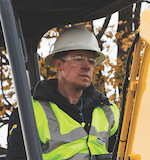 |
|
Joe Boufford |
Mini excavators have a niche in agriculture, too
While most compact excavators are utilized in the construction industry, we are seeing a sustained uptick of the use of compact excavators in specialty agriculture as well in the traditional agriculture sector.
As the rental industry leads in virtually every market segment for compact excavators, it is important to have excavators that can be operated by the non-professional and for lighter-duty work. Due to the compact nature of these machines, they are ideally suited to operate alongside structures and also between rows in orchards or vineyards. The size and usability along with modest price point allow farmers to put these versatile machines to work alongside skid or track loaders for general farm maintenance and larger projects such as trench digging or demolition. Additionally, having a machine that can utilize multiple attachments greatly increases the breadth of possible applications. Augers, compactors, hammers and brush cutters are just a few of the available attachments that allow users to get the most out of their machines.
Fleet management systems give rental houses the ability to keep track of their assets and also allows for planned service scheduling for routine maintenance and service parts orders. Users can geofence their machines, which means creating a geographical perimeter in which the machine can operate. Telematics systems such as New Holland’s FleetForce can transmit error codes to the monitoring center so appropriate action can be taken. The user can also set up diagnostic alerts to warn of any issues with the machine and set up maintenance alerts. By setting up alerts, New Holland FleetForce notifies the owner of a mechanical or electrical issue before it is too late. The analytics can include anything from machine health, runtime hours and performed maintenance. Rental houses can then use this information to improve machine and well as business efficiencies, such as renting a specific excavator based on operator or application.
Having a machine that can utilize multiple attachments creates more opportunity for the customer and therefore more revenue for the rental firm. The hydraulic systems on compact excavators are designed and optimized to deliver constant, powerful hydraulic flow. This allows a digging machine to become a breaker, cutter, mower, compactor or drill/auger. A hydraulic or mechanical coupler enables the user to switch easily between the necessary attachments. Having a ready supply of attachments will help keep the unit in constant use and the number of applications it can perform it greatly increased.
 |
|
Lee Padgett |
Hybrid-powered units gain momentum
As emissions regulations continue to tighten, the call for zero emission operation continues to grow. Takeuchi answers that call with its TB216H electric-hybrid machine.
The TB216H features a 15-horsepower diesel engine that can be used to load/unload the machine, navigate to the job site and then switch to 100 percent emissions-free operation using its onboard 14.2-horsepower electric motor. The TB216H requires a 480-volt three-phase power supply. It can be tethered at lengths up to 1,250 feet.
Fleet management is changing how rental centers better manage their fleets. Having the ability to see a broad, real-time view of a single machine or a whole fleet allows owners to save time and money on maintenance intervals and service calls. Takeuchi Fleet Management (TFM) is standard equipment with two years of service provided on all new machines. TFM can remotely connect users to their Takeuchi machines, providing alerts and machine information including location, performance and maintenance data, giving insights into where and how the excavator is being utilized.
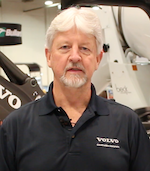 |
| John Comrie Product Manager, Compact Excavators Volvo Construction Equipment |
Short-swing and wheeled excavators fit rental market needs
We’ve seen a need for short-swing excavators that excel in incredibly tight spaces. As a result, Volvo has developed the ECR18E, an ultra-short-swing-radius compact excavator that features a rear overhang of only 0.5 inches when the tracks are fully extended. The improved controllability and simplified operator interface offer more precision and make operation more intuitive. Designed for low cost of ownership and with 50-hour greasing intervals, this machine is particularly suited for rental. Its low height of 79 inches and variable undercarriage width from 39 to 53 inches allows it to work in tight spaces and provides excellent stability once in position.
Volvo developers have also seen increased demand for compact wheeled excavators. Wheeled machines, like the Volvo EW60E, are a great fit for projects like ditch work alongside a road, landscaping, work in congested urban settings or in large subdivisions that require frequent roading from site to site. With an excavator like the EW60E, customers get many of the capabilities of a comparable tracked machine but with the added benefit of being able to travel without the need for a truck and trailer.
Another trend is making the machines easy to service, which can speed maintenance and boost uptime. Our newest models feature 50-hour greasing intervals and a hinged fuel tank that allows easy access to the engine, filters and oil.
When a machine needs to be hauled on a trailer, transportation of the Volvo ECR18E or EC20E models is easy, safe and secure, thanks to their lightweight and convenient design. With automatic slew lock and four tie-down points on the upper frame, each machine can be safely transported on a small trailer with up to three buckets and a hydraulic breaker while maintaining a total transport weight of less than 2 tons.
Double-acting and single-acting hydraulics are also standard on these machines, so if customers want to install a thumb, attachment or hammer, the plumbing is already factory-installed.
 |
| Kent Somerville Director, National Rental Accounts Volvo Construction Equipment |
Trend to electric units is here
Compact excavators have been a growing product category in the North American rental market over the past two to three years, outpacing the growth of some other compact categories as rental operators are seeing new opportunities emerge that may have been covered with backhoe loaders in previous years.
The most obvious emerging opportunity from Volvo CE specifically is the upcoming launch of the Volvo electric compact excavator models, which support Volvo’s strategic priorities around electromobility. We’re extremely excited about the opportunities these products will bring for our customers and for building a more sustainable future.
Rental operators already have unique skills and competencies when it comes to electric mobility and electric rental machines and we look forward to engaging these opportunities.
This article originally appeared in the July-August 2019 issue of Pro Contractor Rentals magazine. ©Urbain Communications, all rights reserved.



